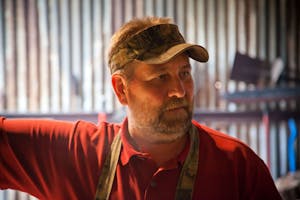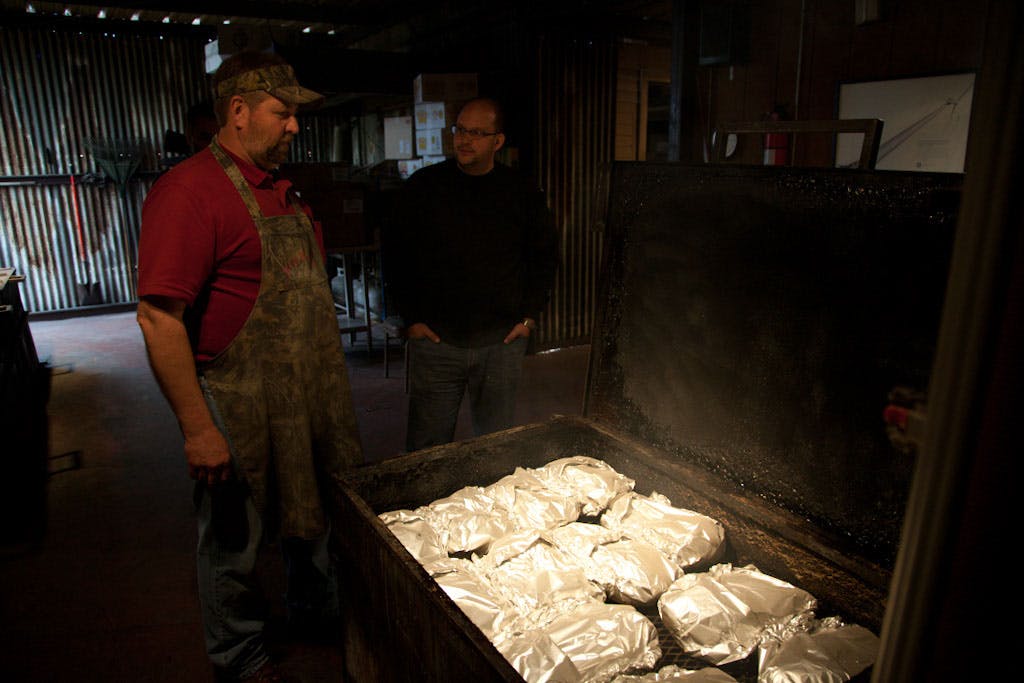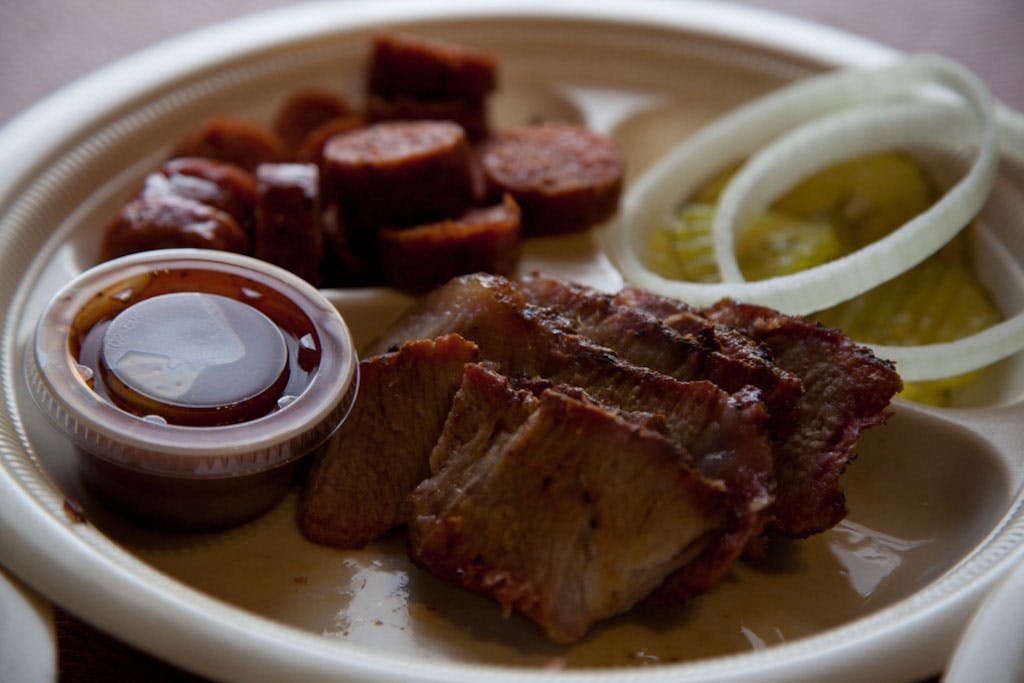
Owner/Pitmaster: Big Boys Bar-B-Que, opened 2000
Age: 57
Smoker: Direct heat steel pits
Wood: Mesquite
I’ve been out to Sweetwater twice for Gaylan Marth’s barbecue at Big Boys. The first time I was with my wife and kids. They stayed in the car while I got a to-go order. Eating in the car we saw a truck speeding up the road into Sweetwater with eight or nine cop cars following close behind. It ended in a crash and shootout in the middle of town where the car thief was shot. It was like the modern day wild west. The second visit was much less dramatic, but it’s where I first tasted Jane Marth’s key lime pie. It may not sound like a traditional barbecue dessert, but it’ll change your mind after one bite. I wish I could have shared some with Gaylan for this interview, but we talked over the phone on his day off.
Daniel Vaughn: How’s business?
Gaylan Marth: Great. It’s really amazing how much barbecue has started to explode in the last few years. We made Top 50 in ’03 and honorable mention in ’08, and that was a big deal, but this year we have people every day that come in and mention that they saw us in the Top 50. It’s one of those things that you can’t put a figure on what it has meant to us.
DV: You’re right there along the interstate. Before the 2013 list how much of your business was from folks who were traveling and how has that changed now?
GM: I can’t really put a figure on it. I just know that we’ve been very busy over the last couple of months since the list came out.
DV: And do those people mention how they heard about you?
GM: From Texas Monthly mainly, and from your book too. We have them both up in the serving window. I’ve also signed quite a few copies of Texas Monthly from folks coming through.
DV: Is there much barbecue competition in the area?
GM: There’s a place right by the interstate here in town, and a little place that my friend owns eight miles away in Roscoe. There are some places in Abilene too.
DV: I guess Abilene’s the closest town of any size?
GM: Yes. It’s forty miles east. Big Spring is about sixty miles west. Then Lubbock is a hundred twenty miles north.
DV: There’s not a whole lot close by.
GM: We’re pretty well isolated out here. The closest in the Top 50 is Pecos, Amarillo, Weatherford and Llano. We’re right in the middle of that circle.
DV: How did you find yourself out there in Sweetwater?
GM: I’m originally from Roscoe. I got married in 1980 and my wife’s parents are from Sweetwater. Now we live about mile south of where the restaurant is.
DV: The restaurant opened in 2000, so what did you do before then?
GM: I was in the cotton ginning business for about twelve or thirteen years. Then I was a Farm Bureau insurance agent for three years. After that I got into the ostrich farming business for about thirteen years. It was after that when we got into the restaurant business. I wish I’d got into it a lot younger.
DV: How old are you?
GM: I’ll be fifty-eight in a couple weeks.
DV: Wow. You look younger.
GM: Well, I noticed in the Top 50 that there’s a bunch of youngsters in there. A bunch are thirty-five or around there. That’s where I wish I was at.
DV: Better late than never, right?
GM: I enjoy cooking and so does my wife, Jane. When the ostrich business went south we needed something else to do. In Sweetwater there wasn’t a whole lot to do that you could be your own boss. We built the building at our place then leased the lot where we moved it. We never had been in the barbecue business before.
DV: Is that when you decided to go with direct heat cooking? How did you come to use that style?
GM: My grandfather and my dad were Germans, so that’s the method I grew up cooking with. There weren’t smokers. You dig a pit and build a fire in it. Then you built another pit to burn the wood down.

DV: Have you ever tried using a smoker?
GM: I built a smoker when we started this thing. I designed and built it myself. I had to keep piling wood into it just to keep the temperature up. I use a lot less wood with the direct heat method.
DV: So you were going to smoke meat when you first opened up?
GM: I had planned to do both. I just couldn’t get used to cooking with the smoker.
DV: I know that you built your own cookers, but I didn’t realize you built the building too.
GM: Back in 2000, we built a 12×20 building here and hauled it up there. When we made the list in 2003 we were still in that tiny building with a few picnic tables on a dirt floor. What you see now, we added all that on too.
DV: Were you cooking out in the open back then?
GM: No. I hate cooking out in the weather. You just can’t hardly do it. One day it’s raining and the next day it’s blowing. It’s just no consistent.
DV: Describe the pits that you’re using.
GM: They’re kind of like Cooper’s. They’re not too heavy. A lot of people use ¼” steel, but these are only 16 gauge. They don’t need to be any thicker because I’m not building a fire in there. If you take a 4’x8′ sheet of metal and cut it into thirds you get three sheets that are 48” x 32”. So 32” is how tall my pits are.
DV: How far above the fire does the meat sit?
GM: I go down 8” for the grates, so it’s two feet above the coals.
DV: So everything on your menu has to be no taller than 8”?
GM: I guess so. About the only thing that gets close is a big turkey. I couldn’t cook a big pig, but I’ve only cooked one pig in my life.

DV: But you’ve cooked plenty of pork. You have two kinds of ribs on the menu, and one of them is called “My Ribs”. What are those?
GM: They’re country style ribs. I don’t understand why more people don’t cook them. They’re so good and they’re hard to mess up. I use the same rub on them as I use on my briskets.
DV: What are the other ribs on the menu?
GM: They’re called “Your Ribs”. It’s a St. Louis cut. I have a sweet Memphis style sauce that I make and a different rub just for them.

DV: Out there on the plains there isn’t much hardwood to choose from. What do you use?
GM: Mesquite. I get it from a local gentleman. He knows exactly what I want.
DV: Those that smoke with mesquite say it’s best if it has been seasoned for at least a year. Is that still the case for wood that used in direct heat cooking where it’s burnt down to coals?
GM: I don’t want anything with green on it at all. You can get some bitter flavors from the coals. I would like something a little milder like pecan, but I know it would cost a lot more out here.
DV: Did your dad and grandfather also use mesquite when they were cooking on the open pits?
GM: Yes.
DV: Did they cook for the family or for big events?
GM: Mainly for family events like birthday parties. It was back in the fifties, sixties and early seventies. We would cook and the whole neighborhood would come over. We’d do goat and sirloin steaks. Brisket just wasn’t a big thing then.
DV: Is there enough goat commercially available for you to cook it at the restaurant?
GM: Yes, but it’s so expensive. To get the true cabrito [young goat] I think my cost would be fourteen or sixteen dollars a pound [for the raw meat].
DV: I noticed there isn’t any ostrich on the menu.
GM: I would if it was readily available. It’s hard to come by. Have you ever had ostrich?
DV: I’ve had an ostrich burger, but that’s it.
GM: It’s good meat. It’s a red meat like beef, but it’s a shade darker. It’s extremely lean, even leaner than turkey. That makes it difficult to cook because it dries out quickly.
DV: When’s the last time you had ostrich at home?
GM: It’s been a long time. Probably back when we were still in the business in the nineties. We really didn’t eat much of it then anyway.
DV: You didn’t let the family get sick of ostrich?
GM: No. We still have seven on the property here. We have a few of our original breeders.
At this point we got into a discussion about cooking over coals versus smoking. I’d mentioned Gaylan’s method of “smoking” a few times in our conversation and he reminded me that he cooks meat, he doesn’t smoke it. In his opinion smoking is for preservation, so there’s no need to smoke meat that you’re going to serve right away.
GM: So many people think the only good brisket has to have black crust and a smoky flavor. You’re not gonna get that when you come here because I don’t use a smoker.

DV: You don’t use a smoker and you also wrap the meat for a large portion of the cooking time, correct?
GM: Yes, I wrap it. I do leave it on the fire a little longer now to get some color and smoke ring that everyone seems to like. When people ask for burnt ends, I tell them I don’t burn my brisket. I don’t like to serve fatty brisket [slices] either because we don’t cook like the other places for sixteen or eighteen hours.
DV: What challenges do you have at the restaurant just from being a bit isolated out in Sweetwater?
GM: Take for instance Franklin or Snow’s that sell out every day – you’re always going to get fresh brisket. Out here in the real world where I’m at, I have briskets that I need to warm up. If I could sell out every day that would be ideal, but I’ve got to stay open from 11:00 to 8:00 here to make my living. It was a week after the Top 50 and I sold out of everything. I had to get up early on Saturday to cook. There were about ten or twelve guys who came over from Abilene that morning and some of them were from the Carolinas. They said it was the best barbecue they’d ever eaten. It’s because it was fresh. That’s what I wish I could do every day.
DV: Why don’t you?
GM: I’ve got to have meat for all the hours that I’m open.
DV: Is it too hard to gamble with how much food you’ll need for the day? Are you always cooking more than you think you’ll need?
GM: Yes. If I run out at 5:00 that’s just not enough working hours for me to make a living. I do run out of chicken every day. Some people do complain when they come in late on a Friday looking for chicken. They get mad when it’s gone, so I have to explain that it’s fifteen ‘til eight. I want to be out of chicken by now.
DV: How many briskets are you cooking every day?
GM: I cook about twelve to fifteen briskets. That usually leaves three or four leftover that I serve warmed up the next day. On a Friday I’ll cook a few more.
DV: What about Saturday? Isn’t that your biggest day?
GM: No. We do 25-30% more on a Friday than Saturday. It’s a big travel day.
DV: I heard you were going to do some traveling of your own. You’re coming down to Austin for the barbecue festival to try some other people’s barbecue. Do you go visit other barbecue joints often?
GM: I enjoy trying other people’s barbecue. If you get too old to learn anything you might as well quit what you’re doing. I want to try Aaron Franklin’s brisket. I’ve heard everyone rave about it, but I want to try it for myself. Funny thing is I just had a gentleman come in over the weekend from Abilene. He came up and introduced himself and said he was Aaron Franklin’s uncle. He said he’d seen us on the TV, so he thought he’d come over and check us out.
DV: Were there any barbecue joints that you went to around Roscoe growing up?
GM: It was really just the barbecue that my dad and grandfather made. When we went to Abilene we’d go to Underwood’s there. That was really the only barbecue joint around.
DV: So you have a few more options in the area these days?
GM: Yes. With all the stuff on the Travel Channel and the pitmaster show, it’s just amazing how big barbecue has gotten.
DV: You watch the barbecue shows?
GM: Yeah. I do. I thought at one point I wanted to start cooking [in competitions], but the way they cook this stuff, I don’t know…
DV: You haven’t brought squeezable margarine or injections into your repertoire?
GM: No. Not at all. The only thing I inject is the Thanksgiving turkey. I don’t know if I could bring myself to do all the stuff to make it like they do on TV.







